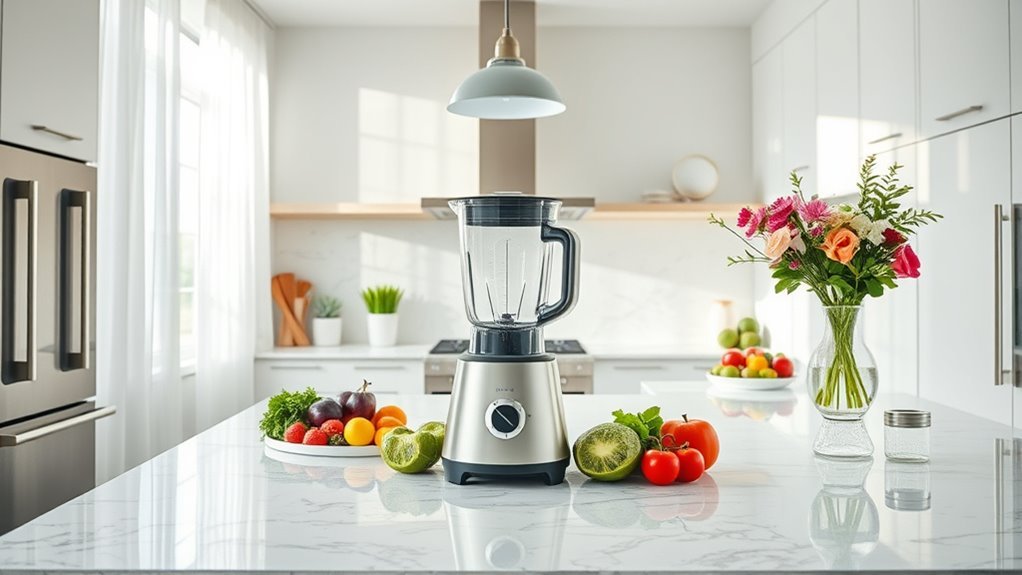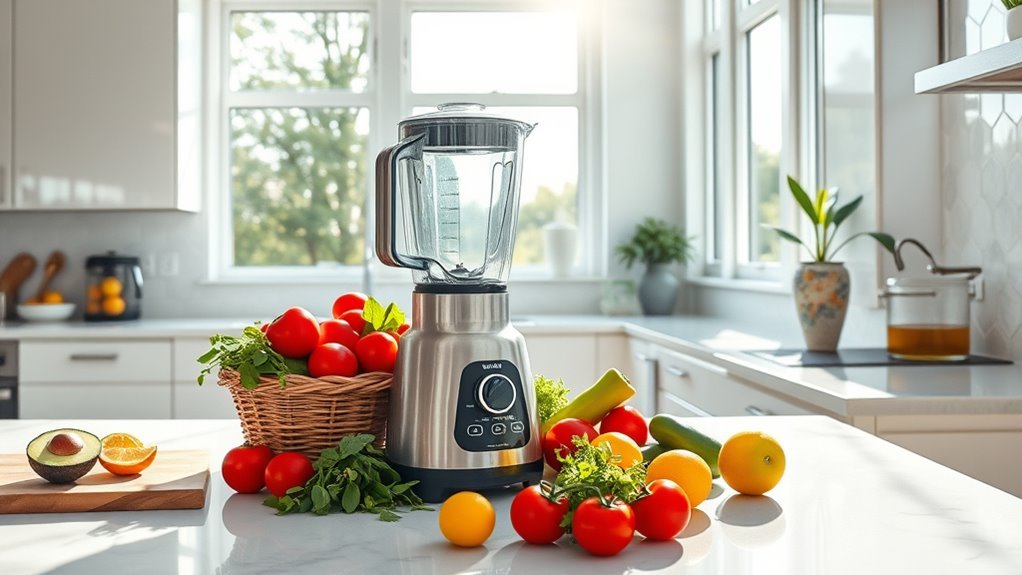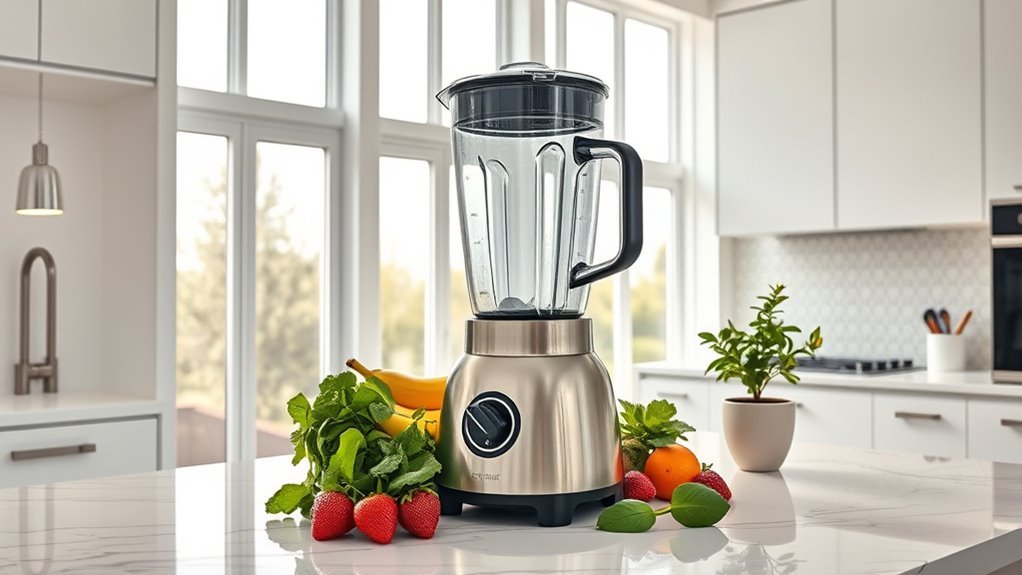We’ve tested the top blender pitcher materials, and here’s what matters: Glass delivers unmatched scratch resistance and clarity but comes with weight. BPA-free plastic offers lightweight safety with potential scratching. Stainless steel brings commercial-grade durability and odor resistance. Tritan copolyester combines the best of glass and plastic. Heat retention varies greatly – glass and steel maintain temperature best. Let’s break down each material’s unique advantages.
Glass Pitcher Performance and Durability Features

Three core attributes make glass pitchers a top choice for serious blending: durability, purity, and aesthetics.
We’re talking unmatched resistance to scratching here – your glass pitcher won’t cloud or wear down with long-term use. Unlike those flavor-hoarding plastic containers, glass maintains a neutral taste profile, never retaining odors or stains from yesterday’s smoothie. It’s completely non-reactive, so go ahead and blend those acidic ingredients without worry.
Let’s talk practical perks: these workhorses are dishwasher safe, making cleanup a breeze while maintaining crystal clarity. The substantial weight provides rock-solid stability during blending – no more counter-dancing while you’re crushing ice. Additionally, glass pitchers are compatible with high-performance blenders, allowing you to achieve smoother textures while preparing your favorite recipes.
And let’s be honest, nothing beats the aesthetic appeal of a sleek glass pitcher proudly displayed in your kitchen.
BPA-Free Plastic Containers: Benefits and Limitations
While glass pitchers dominate the premium segment, BPA-free plastic containers offer compelling advantages for everyday blending.
We’ve found these alternatives deliver critical benefits for health-conscious users without compromising performance.
- Safety comes first – these containers eliminate health concerns associated with harmful chemicals, making them ideal for food storage and preparation.
- The lighter construction prevents shattering while maintaining excellent durability for high-speed blending tasks.
- Enhanced usability through clear visibility lets us monitor the blending process with precision, ensuring consistent results.
- Long-term performance considerations include potential scratching and discoloration, though this rarely affects functionality.
We’re convinced BPA-free plastic containers strike a favorable balance between safety, convenience, and performance for most home blending needs. Additionally, many high-performance blenders offer variable speed settings that enhance blending precision and control as well.
Stainless Steel Pitcher Advantages for Heavy Use

When durability meets performance demands, stainless steel pitchers emerge as the undisputed champions for heavy-duty blending operations.
We’re talking about workhorses that laugh in the face of chips and breaks while maintaining temperatures like it’s their job – because it is.
Let’s cut to the chase: these non-porous beasts don’t play host to lingering flavors or odors from your last blend.
They’re dishwasher safe and clean up faster than you can say “smoothie.”
While plastic containers might leave you replacing them yearly, stainless steel pitchers often come with lifetime warranties – that’s how confident manufacturers are in their reliability.
Think of them as the Navy SEALs of blending: tough, efficient, and ready for whatever you throw at them.
For serious blending operations, they’re simply unmatched.
Tritan Copolyester Material Specifications
Modern blending technology takes a quantum leap forward with Tritan copolyester. This BPA-free plastic revolutionizes blender pitcher construction with its unmatched combination of durability and clarity.
We’re consistently impressed by its glass-like appearance that doesn’t compromise on performance.
- Superior shattering resistance handles maximum blending power while maintaining pitcher integrity.
- High-temperature tolerance means you won’t see warping or chemical leaching when processing hot ingredients.
- Dishwasher safe construction eliminates cleaning hassles and maintains pristine condition through repeated use.
- Built-in resistance to stains and odors keeps your pitcher looking and smelling fresh, even after blending pungent ingredients.
For professional-grade blending without the weight of glass or limitations of standard plastics, Tritan copolyester delivers exceptional performance in every category.
Material Impact on Blending Temperature Control

As you’re pushing the boundaries of blending performance, your choice of pitcher material dramatically impacts temperature control during operation. We’ll break down how different materials handle hot soups and temperature variations while blending.
| Material Type | Temperature Control Properties |
|---|---|
| Glass | Superior thermal stability, even heating |
| BPA-free Plastic | Moderate heat retention, lightweight |
| Stainless Steel | Excellent insulation, maintains temperature |
| Thick Pitchers | Better heat distribution, stable temps |
| Thin Pitchers | Quick heat loss, uneven temperatures |
Let’s be clear: glass blender pitchers shine with hot ingredients, maintaining thermal stability without warping. Stainless steel’s insulation properties keep blended contents hot longer, while BPA-free plastic offers a safe but less temperature-stable alternative. Remember: thicker pitchers provide better insulation regardless of material choice.
Frequently Asked Questions
Is the Oster Better Than the Vitamix?
While the Oster offers great price advantages, we’d recommend the Vitamix for its superior blending efficiency, proven durability, and consistently smoother results, despite both having similar warranty periods.
What Blender Do Professional Chefs Use?
Like titans in the kitchen, we’ve found professional chefs overwhelmingly choose Vitamix and Blendtec for their high-performance features, exceptional durability, and versatile blending capabilities, despite premium price ranges.
Is 900 Watts Good for a Blender?
We’d consider 900 watts adequate for basic blending tasks and smoothie consistency, but it’s mid-range for overall blending efficiency. You’ll notice limitations with ice crushing and tougher ingredients versus higher-powered models.
Is the Kitchenaid K400 Blender Better Than the Vitamix?
We don’t recommend choosing the K400 over Vitamix. While it’s more affordable, Vitamix offers superior motor power, better smoothie quality, longer warranty, and consistently higher user satisfaction in blending performance reviews.

